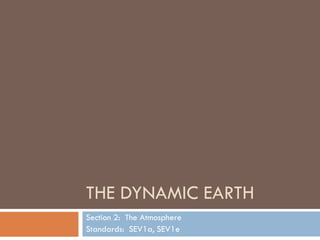
The Atmosphere: Composition, Layers, and Importance
- 1. THE DYNAMIC EARTH Section 2: The Atmosphere Standards: SEV1a, SEV1e
- 2. What is the atmosphere? Mixture of gases that surround the Earth.
- 3. What is the composition of the atmosphere? 78% nitrogen From volcanoes, decaying organisms 21% oxygen From plants 1% various gases: argon, CO2, methane, water vapor Particulates From soil, salt, fire ash, pollen, bacteria, aerosols (tiny, liquid droplets)
- 4. What are the layers of the atmosphere? Troposphere Closest to earth Densest layer Where weather occurs Temperature decreases as you reach upper levels Stratosphere Where ozone layer found Temperature increases as you reach upper levels Ozone layer decreases UV radiation that reaches Earth’s surface Mesosphere Coldest layer Thermosphere Outermost layer Hottest layer but doesn’t feel hot due to lack of heat transfer between air particles
- 5. Why is the atmosphere important? Helps control temperature of planet. Without gases in atmosphere it would be too cold to live here.
- 6. What is “Earth’s Energy Budget”? Solar energy reaches earth as visible light, infrared radiation, and UV light. About 50% reaches surface of Earth and is absorbed by land and ocean. 25% scattered & reflected by clouds 20% absorbed by ozone, clouds, gases 5% reflected by Earth’s surface (light colored)
- 7. How does the atmosphere help control the temperature of Earth? After Earth’s radiation strikes surface of Earth it re-radiates and is trapped by greenhouse gases in atmosphere. Greenhouse gases include: CO2, methane, water vapor, nitrous oxide Greenhouse effect is VITAL- without it planet would be too cold! TOO MUCH greenhouse gas CAN be bad- planet can get too hot.
- 8. How are wind patterns created? Caused by uneven heating of earth’s atmosphere which creates convection currents. Convection currents- air heats up and rises; air cools and sinks; repeat
- 9. Why are cities usually hotter than rural areas? Urban Heat Island Effect Cities have darker surfaces and fewer plants so therefore store more heat and have higher temperatures than Heat Island Video Segments from rural areas. EPA How can this problem be Heat & Health Clip= 2:05 min mitigated (fixed)? Mitigation= 2:06 min Watch video and write down some ideas…